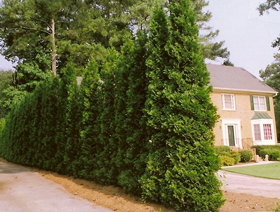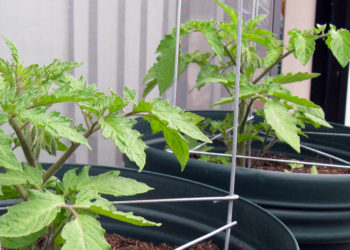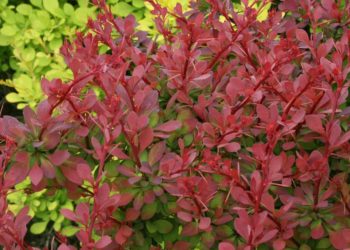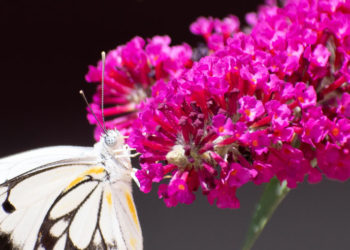Whether you’re looking to grow a living privacy fence or cut down on traffic noise, you’ll want to check out these easy tips on how to grow American Pillar Arborvitae (pronounced are-burr-VEE-tie or are-burr-VY-tee) plants before you start.
The Perfect Natural Privacy Screen
With their tall, narrow shape and ability to grow 3 to 4 feet per year, these evergreen shrubs make a great natural privacy screen. Hardy in zones 3a-8b, they are also deer resistant and mostly disease and insect proof. At maturity, they can reach a staggering twenty five to thirty feet tall and spread three to four feet wide, making them one of the tallest shrubs around.
Combine that with the fact that they are long-lived, have strong root systems, need minimal pruning and can stand up to wind and ice–and you have a standout shrub for almost any environment.
How to Grow American Pillar Arborvitae (for best results)
American Pillar do best in deeply worked, fertile, and well-drained soil. Making sure that your soil is the right consistency is key. It’s a bit of a job, so to save time and energy, the best way to prep your soil is to use a rototiller. Till down about 10 inches deep, then add 1 part peat moss or compost to 4 parts soil. This will increase your drainage.
Once you’ve got the soil prepped, you’ll want to dig a planting hole that’s twice as wide as the root ball. This will give the roots space to stretch out as the shrub matures and grows. The dark green branches are very dense, so if you’re planting them as a living fence, space them only 2 feet apart. This way they will spread into each other and create a tight, ‘living wall’.
When to Plant American Pillar
The best time to plant American Pillar shrubs is in the fall. They become dormant around early November. Or you can do it in the spring in late March before new growth starts. American Pillar Arborvitae shrubs can also be easily transplanted, even at a height of twelve feet.
Growing Tips
Like most broadleaf evergreen shrubs, Arborvitae prefers a slightly acid soil, with a soil pH reading from 5.5 to 6.0. It is best to test your soil before planting. If there is little organic matter in the soil, amend soil by adding peat moss or compost. Newly planted shrubs need a water-soluble starter fertilizer to boost root growth.
American Pillar prefer full sun locations, but will also grow in part sun to some shade. To make this already low maintenance plant even easier to care for, use 2-4 inches of mulch around the base to hold moisture in soil.
Ready to get started on your living fence? Check out our collection of arborvitae and get growing!





6 Comments
Scott
April 11, 2020 at 7:16 amI planted 6 foot American pillars exactly 2 feet from a wire fence. Could this be a problem with growth rate? Could it slow down growth?
I was thinking of moving them in another 6 inches now. Maybe I should wait to see how they grow since I can move them up to 12 feet in height?
GrowJoy Plants
September 18, 2020 at 3:43 pmScott, this reply may come a bit too late but since the American Pillar have a 5 foot spread they should be a minimum of 30 inches from the wire fence. Hope this helps!
Scott
August 1, 2021 at 8:39 amThank you. I’ have another question. The little bulbs of new growth on the trees turned brown and dried at the end of last season. Around September. This year there is new bulbs of little green growth on the trees. Is that brown normal or did that happen due to lack of water?
jstutzman
August 4, 2021 at 11:47 amScott, that sounds like seed pods and it would be a normal part of the growing process. Joe
Tricia
September 4, 2021 at 11:44 pmHi there! I planted 44 American Pillars last August to block the dust and provide privacy from a dirt road that runs behind our house. They haven’t grown much yet, but I have noticed lots of green “bulbs” that have since turned brown. Some of the trees have so many it is weighing the tops down. Is this normal? Should I support them some how? Also how much and when do I fertilize? What is the best fertilizer? I don’t want to lose them- it was a big investment.
Thank you.
Tricia
GrowJoy
September 27, 2021 at 1:05 pmTricia, the bulbs that you’re seeing sound like seed pods, and are a normal part of the growing process. Your arborvitae will produce them each year, you can snip them off if you think they may be weighing the plant down. Otherwise, you can just leave them. In terms of fertilizer, the best fertilizer for arborvitae is one with a high content of nitrogen. It may be a 12-6-4 one or a 10-8-6 one. Fertilize once in the spring and once in the fall for the first few years, then once a year is enough. Enjoy your new hedge!